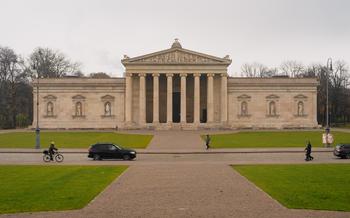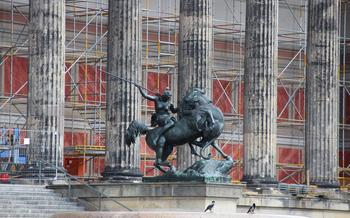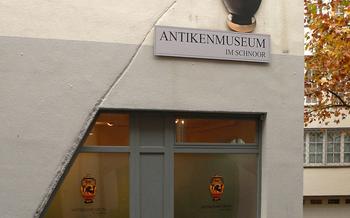
State Collection of Egyptian Art (Staatliche Sammlung für Ägyptische Kunst)
- A Journey into Antiquity: Uncovering the Treasures of the State Collection of Egyptian Art
- Step Back in Time: Exploring the Ancient Egyptian Galleries
- The Egyptian Pantheon: Encountering Deities and Their Significance
- Royal Splendor: Pharaohs, Queens, and Their Opulent Artifacts
- Everyday Life: Glimpsing into Daily Routines and Customs
- The Afterlife: Unveiling Beliefs about Death and the Journey Beyond
- Mummy Mysteries: Unveiling the Secrets of the Dead
- Hieroglyphs and Scripts: Deciphering the Language of the Pharaohs
- Divine Statues and Sculptures: Masterpieces of Ancient Egyptian Art
- Jewelry and Adornments: Unveiling the Art of Personal Expression
- Ceremonial Objects and Ritual Implements: Glimpsing into Ancient Rituals
- Architectural Elements and Building Fragments: Preserving Ancient Structures
- The Amarna Period: Uncovering the Artistic Legacy of Akhenaten
- Mummies and Sarcophagi: Preserving the Bodies of the Deceased
- The Nile River: A Lifeline for Ancient Egypt
- The Rosetta Stone: A Key to Deciphering Hieroglyphs
- Insider Tip: Exploring Beyond the State Collection of Egyptian Art
A Journey into Antiquity: Uncovering the Treasures of the State Collection of Egyptian Art
In the heart of Munich, nestled amidst the bustling streets and vibrant cultural scene, lies a treasure trove of ancient wonders that transport visitors back to the glorious days of pharaohs and pyramids. The State Collection of Egyptian Art, housed within the Kunstareal museum district, is a captivating journey through the rich history and diverse culture of ancient Egypt.
Established in 1905, the collection has grown from humble beginnings to become one of the most significant repositories of Egyptian artifacts outside of Egypt itself. It owes its existence to the passion and dedication of collectors, scholars, and adventurers who were captivated by the allure of ancient Egypt and its timeless treasures.
The collection boasts an impressive array of artifacts that span over 5,000 years of Egyptian history, from the Predynastic Period to the Roman Period. Here, visitors can marvel at iconic pieces that have stood the test of time, including statues of majestic pharaohs, intricately carved reliefs depicting scenes from daily life and religious rituals, and exquisite jewelry that once adorned the bodies of ancient Egyptians.
Each artifact in the collection tells a story, offering a glimpse into the lives, beliefs, and practices of a civilization that continues to fascinate and inspire. Whether it's the haunting gaze of a mummy, the intricate hieroglyphs etched on a temple wall, or the delicate craftsmanship of a golden amulet, the State Collection of Egyptian Art invites visitors to embark on an extraordinary journey through the sands of time.
Highlights of the Collection
Among the many treasures housed within the State Collection of Egyptian Art, several iconic pieces stand out as must-sees for any visitor. The statue of Pharaoh Amenhotep III, with its serene expression and intricate detailing, is a testament to the skill of ancient Egyptian sculptors. The Green Head of Queen Nefertiti, discovered in the workshop of the renowned sculptor Thutmose, offers a glimpse into the beauty and elegance of one of Egypt's most famous queens. And the Narmer Palette, an exquisite ceremonial palette dating back to the Predynastic Period, depicts the unification of Upper and Lower Egypt and is considered one of the most significant artifacts from ancient Egypt.
Thematic Sections
The State Collection of Egyptian Art is divided into several thematic sections, each exploring a different aspect of ancient Egyptian culture. Visitors can wander through galleries dedicated to the Egyptian pantheon, encountering deities such as Osiris, Isis, and Horus, and learning about their roles in Egyptian mythology. Royal splendor is celebrated in galleries showcasing the opulent artifacts of pharaohs and queens, including jewelry, clothing, and ceremonial objects. Everyday life is brought to life through exhibits that depict scenes of farming, fishing, and other daily activities, offering a glimpse into the routines and customs of ancient Egyptians. And the afterlife is explored in galleries that showcase mummies, sarcophagi, and funerary objects, revealing the beliefs and practices surrounding death and the journey beyond.
Step Back in Time: Exploring the Ancient Egyptian Galleries
As you wander through the galleries dedicated to ancient Egypt, you'll be transported back in time to a civilization that thrived millennia ago. Immerse yourself in the realm of Egyptian deities, marvel at the splendor of pharaohs and queens, glimpse into the lives of ordinary people, and uncover their beliefs about the afterlife.
The Egyptian Pantheon: Encountering Deities and Their Significance
In the galleries devoted to the Egyptian pantheon, you'll encounter a captivating array of deities who played crucial roles in the lives of ancient Egyptians. From the sun god Ra, the creator of the world, to the goddess Isis, the protector of women and children, each deity had a unique story and significance. Learn about their attributes, their relationships with one another, and how they were worshipped by the ancient Egyptians.
Royal Splendor: Pharaohs, Queens, and Their Opulent Artifacts
Ancient Egypt was ruled by powerful pharaohs and queens who were considered divine beings. Explore the galleries showcasing their opulent artifacts, including majestic statues, intricate jewelry, and elaborately decorated objects. Discover the lives of iconic rulers like Tutankhamun, whose tomb was discovered intact in the Valley of the Kings, and Hatshepsut, one of the most successful female pharaohs in Egyptian history.
Everyday Life: Glimpsing into Daily Routines and Customs
Beyond the realm of gods and pharaohs, the galleries offer glimpses into the daily lives of ordinary ancient Egyptians. Explore artifacts that shed light on their occupations, such as tools used by artisans and farmers, as well as objects that adorned their homes and temples. Discover the importance of the Nile River, the lifeblood of ancient Egypt, and how it influenced their agricultural practices and religious beliefs.
The Afterlife: Unveiling Beliefs about Death and the Journey Beyond
The ancient Egyptians had a complex belief system surrounding death and the afterlife. In the galleries dedicated to this topic, you'll encounter artifacts that provide insights into their rituals and beliefs. Explore the process of mummification, the elaborate tombs and coffins that were created to protect the deceased, and the objects that were buried with them to ensure their safe passage into the afterlife.
Mummy Mysteries: Unveiling the Secrets of the Dead
The State Collection of Egyptian Art houses a remarkable collection of mummies, providing a fascinating glimpse into the ancient Egyptian belief in the afterlife. Through the process of mummification, the Egyptians sought to preserve the bodies of the deceased, ensuring their successful journey to the next realm.
The Art of Mummification: Techniques and Rituals of Preserving Bodies
Mummification was a complex and intricate process that involved multiple steps. The body was first washed and purified with natron, a natural salt, which helped to dry and preserve the skin. The internal organs, except for the heart, were removed and placed in canopic jars for preservation. The body cavity was then filled with linen, sawdust, or other materials to maintain its shape.
Royal Mummies: Unraveling the Stories of Ancient Egyptian Rulers
The collection includes mummies of several pharaohs and queens, including the well-preserved mummy of Pharaoh Seti I, the father of Ramses II. The royal mummies offer a glimpse into the lives and reigns of these powerful rulers, revealing their physical characteristics, health conditions, and even their cause of death.
Animal Mummies: Exploring the Sacred Significance of Animal Veneration
In addition to human mummies, the collection also features a variety of animal mummies, including cats, dogs, baboons, and even crocodiles. These animals were considered sacred in ancient Egypt and were often mummified after their death to ensure their safe passage to the afterlife.
Mummy Portraits: Capturing the Essence of Individuals in the Afterlife
The collection also includes a number of mummy portraits, which were painted on wooden panels and placed over the faces of the mummies. These portraits provide a unique glimpse into the appearance and individuality of the deceased, offering a sense of their personality and humanity.
Hieroglyphs and Scripts: Deciphering the Language of the Pharaohs
The State Collection of Egyptian Art houses a remarkable collection of hieroglyphs and scripts, providing a glimpse into the ancient Egyptian language and writing system. Among the highlights is the Rosetta Stone, a pivotal artifact that played a crucial role in deciphering hieroglyphs. Discovered in 1799 by French soldiers, this stele features three versions of the same text: hieroglyphic, demotic, and Greek. The Greek text served as a key to unlocking the meaning of the hieroglyphs, allowing scholars to gradually decipher the ancient Egyptian language.
The collection also showcases a variety of other hieroglyphic inscriptions, offering insights into the diverse uses of this writing system. From royal decrees and religious texts to funerary inscriptions and everyday records, these artifacts provide a window into the lives and beliefs of ancient Egyptians. Visitors can explore the evolution of hieroglyphs over time, from their early pictographic forms to the more complex and stylized versions that developed later.
In addition to hieroglyphs, the collection features examples of other ancient Egyptian scripts, such as hieratic and demotic. Hieratic, a cursive form of hieroglyphs, was commonly used for administrative and literary purposes, while demotic, a simplified form of hieratic, emerged during the Late Period as the everyday script of ancient Egypt. These scripts offer further insights into the linguistic and cultural diversity of ancient Egypt.
Through its collection of hieroglyphs and scripts, the State Collection of Egyptian Art provides visitors with a unique opportunity to explore the fascinating world of ancient Egyptian language and writing. From the iconic Rosetta Stone to the diverse range of inscriptions and texts, the collection offers a glimpse into the rich cultural heritage of ancient Egypt and the ingenuity of its people.
Divine Statues and Sculptures: Masterpieces of Ancient Egyptian Art
The State Collection of Egyptian Art in Munich houses a remarkable collection of divine statues and sculptures, offering a glimpse into the artistic prowess and religious beliefs of ancient Egypt. These masterpieces, carved from stone, wood, and other materials, showcase the exceptional craftsmanship and attention to detail that characterized Egyptian art.
Pharaohs and Deities: Majestic representations of pharaohs and deities stand tall in the museum's galleries. These sculptures, often larger than life-size, exude an aura of power and divinity. The pharaohs are depicted in various poses, conveying their authority and connection to the divine realm. Deities, such as Osiris, Isis, and Horus, are portrayed with distinctive attributes and symbolic elements, highlighting their specific roles and significance in the Egyptian pantheon.
Animal-Headed Deities: Among the most intriguing sculptures in the collection are those depicting animal-headed deities. These hybrid forms, such as the jackal-headed Anubis, the ibis-headed Thoth, and the falcon-headed Horus, represent the fusion of human and animal characteristics, symbolizing the divine powers and attributes associated with these deities.
Everyday Objects: Beyond the representations of pharaohs and deities, the collection also features a range of sculptures depicting everyday objects and scenes from daily life. These sculptures provide valuable insights into the mundane aspects of ancient Egyptian society. From wooden models of boats and agricultural tools to intricate carvings of furniture and household items, these artifacts offer a glimpse into the daily routines and activities of the ancient Egyptians.
Royal Statues: The museum's collection includes a number of royal statues, which offer a glimpse into the power and authority of the pharaohs. These statues, often made from durable materials such as granite or diorite, depict the pharaohs in various poses and regalia, symbolizing their divine status and their role as intermediaries between the gods and the people.
Exploring the divine statues and sculptures at the State Collection of Egyptian Art is a journey into the heart of ancient Egyptian religious beliefs and artistic expression. These masterpieces, with their intricate details and symbolic meanings, provide a profound insight into the culture and civilization of one of the world's most fascinating ancient societies.
Jewelry and Adornments: Unveiling the Art of Personal Expression
The ancient Egyptians were renowned for their exquisite jewelry and adornments, which served both practical and symbolic purposes. Skilled artisans crafted intricate pieces using precious metals like gold, silver, and electrum, as well as semi-precious stones such as turquoise, lapis lazuli, and carnelian. These adornments were not merely decorative; they held deep cultural significance and were often imbued with protective powers.
Precious Metals and Gemstones:
The Egyptians believed that certain metals and gemstones possessed inherent magical qualities. Gold, for instance, was associated with the sun god Ra and was believed to have protective properties. Silver was linked to the moon god Khonsu and was thought to bring good luck. Gemstones, with their vibrant colors and unique properties, were also believed to possess specific powers. Turquoise, for example, was thought to protect against evil spirits, while lapis lazuli was believed to promote fertility.
Symbolism and Meaning:
Beyond their aesthetic appeal, Egyptian jewelry often carried symbolic meanings. Amulets, small objects often worn as pendants or bracelets, were believed to offer protection and good fortune. Scarabs, beetle-shaped amulets, were particularly popular and were associated with the god Khepri, who was linked to rebirth and transformation.
Royal Regalia:
The pharaohs and queens of ancient Egypt wore elaborate jewelry as symbols of their power and authority. Their crowns, necklaces, bracelets, and earrings were often adorned with precious metals, gemstones, and intricate designs. These adornments not only enhanced their regal appearance but also served as powerful symbols of their divine status.
Fashion Accessories:
Jewelry was not exclusive to royalty; people from all walks of life adorned themselves with various accessories. Women wore necklaces, earrings, bracelets, and anklets made of beads, metal, or leather. Men often wore signet rings and amulets as symbols of their social status or profession. Jewelry was not only a form of personal expression but also a reflection of one's place in ancient Egyptian society.
Ceremonial Objects and Ritual Implements: Glimpsing into Ancient Rituals
The State Collection of Egyptian Art houses a diverse array of ceremonial objects and ritual implements, offering a glimpse into the religious and spiritual practices of ancient Egypt. These artifacts played a crucial role in various ceremonies, rituals, and religious practices, shedding light on the beliefs and customs of the ancient Egyptians.
Among the notable objects are intricately crafted vessels used for offerings to the gods. These vessels, often made of precious materials such as gold, silver, or faience, were used to present offerings of food, drink, and other items to the deities. Statues and statuettes of gods and goddesses were also used in rituals, serving as representations of the divine figures and facilitating communication with them.
Funerary practices held immense significance in ancient Egypt, and the collection includes various objects associated with death and the afterlife. Amulets and scarabs, believed to possess protective powers, were placed with the deceased to ensure their safe passage to the afterlife. Canopic jars, used for preserving the internal organs of the deceased, played a crucial role in the mummification process.
Beyond religious rituals, the collection also showcases objects used in everyday rituals and practices. Cosmetic palettes, mirrors, and combs provide insights into personal grooming and beauty routines in ancient Egypt. Additionally, ritual implements such as sistrums (musical instruments) and incense burners were used in various ceremonies and festivals to honor the gods and goddesses.
Architectural Elements and Building Fragments: Preserving Ancient Structures
The State Collection of Egyptian Art also houses a remarkable collection of architectural elements and building fragments that provide valuable insights into ancient Egyptian construction techniques and artistic styles. These remnants of lost monuments, including temple reliefs, columns, capitals, and statues, offer a glimpse into the grandeur of ancient structures that have long since disappeared.
-
Temple Reliefs and Inscriptions: The collection features an array of temple reliefs and inscriptions that once adorned the walls of ancient Egyptian temples. These intricate carvings depict scenes from mythology, religious rituals, and historical events, offering a glimpse into the beliefs and practices of ancient Egyptian society.
-
Columns and Capitals: The collection showcases a variety of columns and capitals that exemplify the architectural prowess of ancient Egyptians. These impressive structures, often adorned with intricate carvings and hieroglyphs, demonstrate the skill and artistry of ancient Egyptian craftsmen.
-
Statues and Reliefs from Temples and Tombs: The museum also houses a collection of statues and reliefs that were originally located in temples and tombs. These sculptures depict gods, goddesses, pharaohs, and other important figures, providing a glimpse into the religious and funerary practices of ancient Egypt.
-
Architectural Fragments: In addition to complete architectural elements, the collection also includes numerous fragments of buildings and monuments that have been carefully preserved. These fragments, though incomplete, offer valuable clues about the construction and design of ancient Egyptian structures.
The Amarna Period: Uncovering the Artistic Legacy of Akhenaten
Akhenaten's Reforms: The Amarna period marks a unique and transformative chapter in ancient Egyptian history, characterized by the reign of Pharaoh Akhenaten (Amenhotep IV). Akhenaten's rule was marked by significant religious and artistic reforms that challenged traditional beliefs and practices. He introduced the cult of Aten, the sun disk, as the sole deity, and moved the capital city from Thebes to Amarna (Akhetaten).
Amarna Art: The artistic style of the Amarna period is distinctively different from earlier and later periods of ancient Egyptian art. Amarna art is characterized by a more naturalistic and expressive style, with elongated figures, almond-shaped eyes, and a greater emphasis on individual features. This style is particularly evident in the numerous sculptures, reliefs, and paintings that have been discovered at Amarna.
Amarna Letters: The Amarna Letters are a collection of diplomatic correspondence discovered at Amarna. These letters provide valuable insights into the international relations of ancient Egypt during the Amarna period. They reveal the diplomatic exchanges between Akhenaten and the rulers of neighboring states, as well as the political and cultural interactions of the time.
Legacy of Akhenaten: Despite the eventual abandonment of Amarna and the return to traditional religious practices after Akhenaten's death, his reign left a lasting impact on ancient Egyptian history. The artistic legacy of the Amarna period continued to influence Egyptian art in later periods, and the Amarna Letters remain an important source of information about ancient Egyptian diplomacy and international relations.
Mummies and Sarcophagi: Preserving the Bodies of the Deceased
The ancient Egyptians' belief in the afterlife extended to the preservation of the physical body. Mummification, a complex and elaborate process, was developed to ensure the deceased's successful journey into the next world.
The mummification process involved several steps, including removing the internal organs and preserving them in canopic jars. The body was then dried using natron, a salt-like substance, and wrapped in linen bandages. Amulets and other objects were placed between the layers of bandages to protect the body and provide it with divine assistance in the afterlife.
Sarcophagi, or coffins, were used to house the mummified bodies. These containers were often made of wood, stone, or cartonnage, a type of papier-mâché. They were elaborately decorated with paintings and hieroglyphs depicting scenes from the deceased's life, as well as protective spells and prayers.
Canopic jars, with their distinctive human-headed lids, were used to store the internal organs removed during mummification. Each jar was associated with a specific organ and was guarded by one of the four sons of Horus, the protector god of the dead.
Mummy masks were placed over the head of the mummy to provide a realistic and idealized representation of the deceased. These masks were often made of wood, cartonnage, or gold and were painted with the features of the individual. They were believed to protect the identity of the deceased and to facilitate their recognition in the afterlife.
The Nile River: A Lifeline for Ancient Egypt
The Nile River, the longest river in the world, played a pivotal role in the development and sustenance of ancient Egyptian civilization. It was the lifeblood of the ancient Egyptians, providing water for drinking, irrigation, and transportation. The river's annual flooding deposited rich, fertile soil along its banks, making it ideal for agriculture, the foundation of the Egyptian economy.
The ancient Egyptians revered the Nile as a divine entity and associated it with several deities. The god Hapi, personifying the annual flooding of the Nile, was revered as a bringer of abundance and fertility. Other deities, such as the crocodile god Sobek and the hippopotamus goddess Taweret, were also associated with the river and were believed to protect and guide those who traveled on its waters.
Scenes depicting the Nile River and its significance are commonly found in Egyptian art. The river is often portrayed as a sinuous body of water teeming with fish, birds, and aquatic plants. Boats of various sizes, carrying people and goods, navigate the river's currents, symbolizing the importance of transportation and trade.
The Nile River's impact on ancient Egyptian agriculture was profound. The annual flooding deposited a layer of rich, fertile soil along the riverbanks, creating ideal conditions for farming. The Egyptians developed a sophisticated system of irrigation canals and basins to control the floodwaters and distribute them to their fields. This allowed them to cultivate a variety of crops, including wheat, barley, flax, and vegetables, which formed the basis of their diet.
The Nile River was not only a source of sustenance but also a vital artery for transportation and trade. The Egyptians constructed boats of various sizes and designs to navigate the river's waters. These boats were used to transport people, goods, and building materials throughout the kingdom. The Nile also facilitated trade with neighboring regions, such as Nubia and the Mediterranean coast, allowing the Egyptians to acquire exotic goods and establish diplomatic relations.
The Rosetta Stone: A Key to Deciphering Hieroglyphs
The Rosetta Stone stands as one of the most significant archaeological discoveries in history, playing a pivotal role in deciphering the ancient Egyptian hieroglyphic script. Found in 1799 by French soldiers during Napoleon's Egyptian campaign, the stone presented a decree issued by Ptolemy V Epiphanes in 196 BC, written in three scripts: hieroglyphs, Demotic script, and Greek.
The Greek text, which scholars could decipher, provided a key to unlocking the mysteries of the other two scripts, leading to the eventual decipherment of hieroglyphs by Jean-François Champollion in 182Champollion's groundbreaking work revolutionized the study of ancient Egyptian history and culture, enabling scholars to read and understand hieroglyphic inscriptions and texts on monuments and artifacts.
The Rosetta Stone is not only a linguistic marvel but also a testament to the enduring legacy of ancient Egyptian civilization. Its discovery allowed researchers to bridge the gap between the ancient world and the present, providing invaluable insights into the lives, beliefs, and achievements of the ancient Egyptians. Today, the Rosetta Stone is housed in the British Museum in London, where it continues to captivate and inspire visitors from around the world.
Insider Tip: Visiting the Rosetta Stone Gallery
To fully appreciate the significance of the Rosetta Stone, visit the Rosetta Stone Gallery at the British Museum in London. This dedicated gallery provides a comprehensive overview of the stone's discovery, history, and its role in deciphering hieroglyphs. You can see the stone up close, examine its intricate carvings, and learn about the remarkable story of its rediscovery and translation. The gallery also features interactive displays, multimedia presentations, and expert commentary, offering a deeper understanding of this extraordinary artifact and its enduring impact on our understanding of ancient Egypt.
Insider Tip: Exploring Beyond the State Collection of Egyptian Art
-
Glyptothek: A hidden gem located near the State Collection of Egyptian Art, the Glyptothek houses an impressive collection of ancient Greek and Roman sculptures. Don't miss the iconic statue of "Barberini Faun" and the majestic "Medusa Rondanini."
-
Egyptian Museum of Munich: Although smaller than the State Collection, the Egyptian Museum of Munich offers a unique perspective on ancient Egyptian art and culture. Explore its collection of papyri, amulets, and other fascinating artifacts.
-
Guided Tours: Enhance your visit by joining a guided tour led by an expert Egyptologist. These tours provide in-depth insights into the artifacts, their historical context, and the significance of ancient Egyptian culture.
-
Photography: Capture the beauty of the artifacts with your camera, but be mindful of any restrictions or guidelines regarding photography within the museums. Use natural light to avoid reflections and ensure your flash is turned off.









